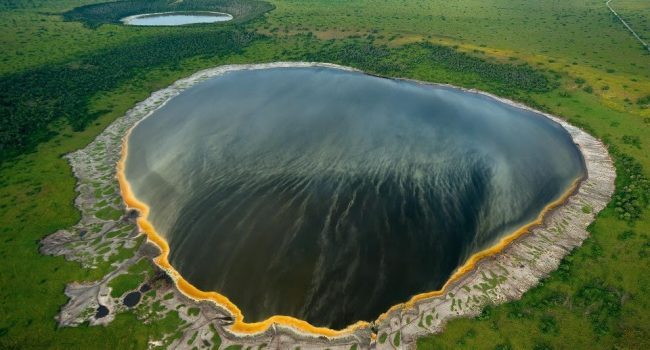Lake Katwe Explosion Craters

Lake Katwe Explosion Craters
Explosion crater lakes in Uganda can be found around Queen Elizabeth national park. They are located in the northern part of the Mweya peninsula the main Crater Lake is ‘Lake Katwe’ the number one salt distributor in Uganda the lake is 3,265 feet depth not able to habituate any animals because of salty water however elephants, buffaloes, flamingos and baboons can be seen at the baboon cliff
This ancient lakes are believ
Lake Katwe Explosion craters in Uganda are found around Queen Elizabeth national park. They are located in the northern part of the Mweya peninsula the main Crater Lake is ‘Lake Katwe’ the number one salt distributor in Uganda the lake is 3,265 feet depth not able to habituate any animals because of salty water however elephants, buffaloes, flamingoes and baboons can be seen at the baboon cliff
It is just a 27km drive through the craters in Queen Elizabeth national park. Along the way you can spot some animals like the loser buffaloes; lonely male buffaloes and elephants.
The Katwe Craters are located north of Mweya peninsular. They are the highest elevation within Queen Elizabeth national park in Western Uganda. You can get to see the great western rift valley of Africa and the escarpments during the drive. You will also see Lake George, a chance of Mountain Rwenzori ranges and Kazinga Channel that connects Lake Edward to Lake George.
Several volcanoes in western Uganda where violent leading to the formation of the explosion craters that spot western Uganda; Bushenyi district, Kasese and Fort Portal. The Katwe craters are known as extinct however, some still eject sulphurous gas smells.
Katwe explosion craters are very beautiful views for hiking in Queen Elizabeth National Park found in the western side of Uganda. You would not want to miss the Kitagata Lake that is fed by the salty hot springs. This lake has no wild life around but very beautiful to view and do hikes around it.
The Katwe Explosion Craters will elevate your hiking experience when you visit Queen Elizabeth national park. “Top of the world” hike near fort portal will lead you to more crater lakes through the villages, and through tea plantations, what a beautiful alchemy this makes!
You will also get a chance to visit the long ago salt works at Lake Katwe. Here you will get information on how salt is formed from super/ hyper concentrated saline water during the dry season. You will find out how hard this kind of work is for it can cause sexual problems to the miners, but, despite, they still work hard like their lives depend on salt mining, which is true, the living of the people in Katwe village depend on salt mining. So, you can show some support to the community when you buy crafts from them.
The crater at fort portal is one of the folk stories in western Uganda; called the “kasesankarange” meaning the thrower of roasted material from the mouth or stomach; spew. You wouldn’t want to miss the story as told by the local people in the community.
During the hikes, you will encounter wild animals like monkeys, baboons at Nyamunuka Crater Lake, tropical birds and also the eye catching flamingo migratory birds in Queen Elizabeth National Park. It is said that they migrate from Europe during the winter season and come to experience warmth in western Uganda. You will see them bedding on the shores of Kitagata salty (no life around), it is okay if you why of all places they chose to stay near to salty crater lakes.
The other crater lakes include; Bunyaruguru Crater Fields. These are located in Kichwamba escarpment of the western rift valley. For example, Lake Nkugute, which you can see from Mbarara- Kasese road, and 20 more craters are found in this region. Imagine how spotted is the west with crater!
Another crater field is Ndali- Kasenda Crater Fields near Fort Portal- Kibale Forest. Unlike in the national park; queen Elizabeth national park. Craters here are explored on foot. This is where the top of the world hike is done, during, you will see the mountains of the moon, go through tea plantations, Kibale Rain Forest, Lake Goerge and Kichwamba escarpment of the western rift valley.
The fort portal crater fields are the smallest in the west of Uganda. They have lakes like Lake Kyaninga. If you happen to have some dollars to save you can lodge in the up-market Kyaninga Lodge overlooking the Crater Lake; it is actually a short distance hiking from the crater to thee lodge.
Accommodation should not be your worry, queen Elizabeth national park is spotted with a lot of accommodation facilities;
- Kyaninga Logde
- Ndali Lodge
- Cvk Lodge
These are the nearest to the craters however you can also lodge in Mweya Hostels, Mweya Safari Gorge Lodge, Park View Lodge, Katwe Camp, among others.
Surely the Katwe Craters should be on your must do list when you visit Queen Elizabeth national park, Bwindi Forests, Kibale National Park. At least let the beautiful scenery attract you to involve in this activity.
ed to have been formed as a result of violent volcanic eruptions this explosions were so violent that instead of piling debris just about their vents they instead widely released ash to the far areas.
Today they are known as crater lakes and some of this lakes are still releasing Sculpture smells. These lakes are; The Ndali Kasenda crater, Bunyaraguru on the Kichambwa escarpment and Kyemengo the most beautiful. A few years before Christ this lakes continued gushing volcanic fire and brimstone continued to erupt from this crater explosion lakes.
They have no outflows for water hence making the water salty.
Plenty of wildlife such as elephants, monkeys as well as many bird species can be seen throughout the 27kilometre drive around the lakes, the crater lakes are also positioned in an area with breathtaking views of the great western arm African rift valley with its enormous escarpments.
In the local communities of the people of western Uganda they still speak of the crater lakes like kasesankarange in fort portal meaning spewer of roasted materials. Some of these lakes still contain molten lava and are likely to explode in years to come probably not when your on safari just enjoy the extraordinary views for time being, the three main lakes mentioned above are not the only crater lakes found therein but others are present the area contains over 20 crater lakes with some being dry.
This lakes can be found near kibale forest and fort portal area and can be accessed on foot one of the hikes one can take here are “on top of the world” hike offering panoramic views of the right valley escarpments and mountains of the moon among others u can also add a nature guided walk to kibale forest to your itinerary touring can take half day to a full day tour. Accommodation unit can also be found around here.
This explosion crater lakes also attract various numbers of birds such as the lesser plus flamingos,
Apart from explosion crater lakes in Queen Elizabeth National Park, the park has a lot to offer starting from the impressive views of this crater lakes to the fresh water body lakes George and Edward not forgetting the stunning Kazinga channel with it’s numerous hippos, crocodiles and views of elephants in the afternoon with the overlying views of the ishasha and Kasenyi plains over looking the mountains of the moon and Kasese town and fishing villages.
Not forgetting to visit the Lake Katwe fishing village and see people’s way of life and lean how salt is mines though the mining processes haven’t changed in the recent years one can also add a chimpanzee trekking trip to their travel list and view chimpanzees at the great kyambura “ the valley of apes” including the baboon cliff near lake Katwe. Visiting this explosion crater lakes can take a full day itinerary tour and a unique experience of the volcanic eruptions


